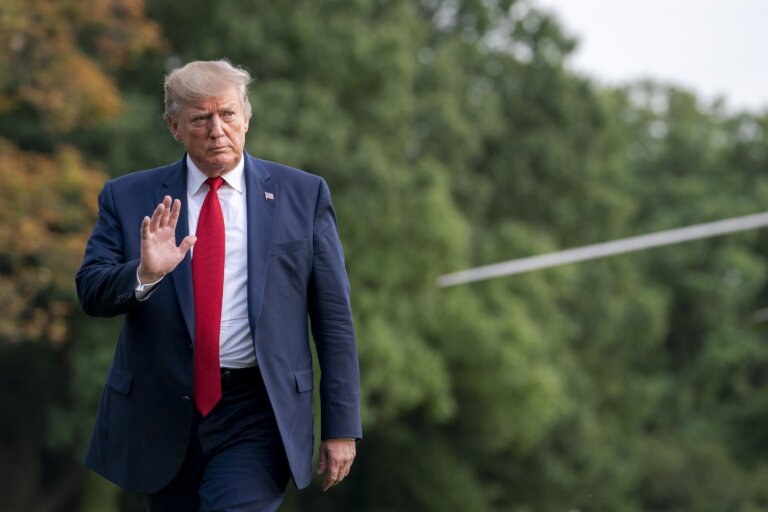On April 29, the administration of President Donald Trump celebrated its first 100 days in office. Most of President Trump’s motivations could be explained within an economic framework, which aligns with his lifelong experience as a successful businessman. His preoccupation seems to be with improving the efficiency and effectiveness of the government and the economy, achieving prosperity, and the peace it requires. If this understanding is correct, it bodes well for the coming years—not just for the United States, but for all those around the world who oppose the institution of Global Governance.
Donald Trump’s 2024 Agenda
President Trump’s political platform for the 2024 elections was summarized in 20 promises, revolving around three major areas of concern: stopping World War III, preventing economic collapse, and restoring the proper functioning of the United States (including the control of its borders, immigration policy, ensuring free and fair elections, and protecting economic and personal freedoms, as well as the safety of American citizens). These 20 promises form the foundation of the Trump administration’s response to what it seems to perceive as clear and present threats to the very existence of the United States. Many of these promises are closely connected with each other, and addressing one of them will have an impact on others—requiring a careful balancing act.
Following the announcement of the platform in July 2024, Trump’s team was joined by Robert F. Kennedy Jr., who introduced a health dimension (“Make America Healthy Again”), which is closely connected to each of the above-mentioned three main areas. This addition made the diagnosis of the situation more dire and the challenges ahead much greater. The success of the Trump administration’s endeavor is far from assured and will encounter significant opposition, both foreign and domestic. Among the opponents are supranational organizations like the UN and WHO, large transnational corporations, other countries vying for hegemonic positions in the newly forming multipolar world, and a substantial number of internal opponents who support transnational or global governance. These actors have been working for decades to advance agendas that are in clear contravention of the Trump administration’s platform. However, some perceive this presidency as the last opportunity to save and perhaps even restore the American project to its previous greatness. This sense of urgency is uncompromisingly driving the administration’s actions.
The UN’s 2030 Agenda
When the United Nations adopted its 2030 Agenda for Sustainable Development Goals during the final years of the Obama administration in 2015, it seemed that progress toward their achievement would be smooth and uninterrupted. The US economy had recovered from the 2007–2009 financial crisis, which had resulted in a significant transfer of wealth to the richest 10% of the US population. The UN’s 2020 agenda included, among other items, goals for the WHO (e.g., global vaccination coverage targets) and for the International Organization for Migration, which were later elaborated in the 2018 Global Compact for Safe, Orderly, and Regular Migration.
The vision of the future presented by these developments was summarized in a World Economic Forum video titled 8 Predictions for the World in 2030. These predictions described a world in which “you’ll own nothing,” “the US won’t be the world’s leading superpower,” “you’ll eat much less meat,” “a billion people will be displaced by climate change—we’ll have to do a better job at welcoming and integrating refugees,” “polluters will have to pay to emit carbon dioxide—a global price on carbon will help make fossil fuels history,” and “Western values will be tested to the breaking point.”
Trump’s First Term
However, the great wealth transfer of 2013–2016 created so much discontent among the US middle class that voters turned away from mainstream politicians of both leading political parties and elected a political outsider as President in November 2016. Donald John Trump, who had previously been a registered Democrat, ran on an agenda of Making America Great Again and putting America First. His platform included opposition to immigration and the Trans-Pacific Partnership, which he viewed as detrimental to US economic interests. He defended citizens’ Second Amendment rights (i.e., the right to keep and bear arms), was an unlikely pro-life candidate, a proponent of repealing Roe v. Wade, a skeptic of the global warming agenda, and an opponent of the Affordable Care Act (“Obamacare”), which he promised to repeal in favor of free-market principles.
By embracing this platform, he became a major obstacle to the realization of many globalist predictions. He defeated Jeb Bush (the son and brother of former presidents), and Senators Ted Cruz, Marco Rubio, and Rand Paul in the Republican primaries. He then scored a shocking victory over establishment candidate Hillary Clinton in the general election. His victory upset global plans and delayed their implementation significantly.
To the surprise of skeptics, Trump stuck to his pro-life campaign promises, despite facing resistance from the US bureaucracy and judiciary. His administration was instrumental in launching the Geneva Consensus Declaration on promoting women’s health and protecting the family. He participated in the Washington March for Life and nominated originalist judges to the Supreme Court, which eventually led to the overturning of Roe v. Wade. He worked to control illegal migration, attempted to reshore manufacturing, promoted oil and natural gas exploration (making the US a leading fossil fuel exporter), and withdrew the US from the Paris Agreement on climate change mitigation. He renegotiated trade deals with Canada and Mexico and attempted to strike a new trade agreement with China to reduce America’s massive trade imbalance with that country. However, the deal was rejected by China in May 2019, escalating the trade war and prompting Chinese media to call for a “people’s war” against the US.
Donald Trump’s economic policies were largely successful—deficit spending was reduced, inflation decreased, and economic growth was stimulated, resulting in real wage increases for US workers for the first time in decades. All of this was abruptly halted by the COVID-19 pandemic and its associated countermeasures, including lockdowns and travel bans.
The Consequences of Joe Biden’s Term
On January 20, 2021, Joe Biden was sworn in as President of the United States. He began his term by reversing many of his predecessor’s policies, including restricting oil and gas drilling, limiting fossil fuels, pivoting to renewable energy, and banning internal combustion engines. His administration also rejoined the WHO (February 3, 2021), withdrew from the Geneva Consensus Declaration (January 28, 2021), and reversed Donald Trump’s immigration restrictions, among other measures.
Biden’s inauguration marked an acceleration in the implementation of actions targeting the UN’s 2030 goals.
During his presidency, at least 9.7 million illegal immigrants entered the United States (though some estimates are higher), increasing the population by about 3%—mostly with young, military-age men from different regions, cultures, and religions.
The war in Ukraine, which had simmered since 2014 in the Donbas region, escalated into a full-scale invasion by Russia after several missteps by the Biden administration, including a comment that a “minor incursion” into Ukraine might go unpunished. The war devastated Ukraine, killed hundreds of thousands, displaced millions, and cost Western allies hundreds of billions of dollars—pushing them toward financial distress. It also brought the US and Russia, two nuclear superpowers, dangerously close to direct military conflict.
The war fractured US-Russia and EU-Russia relations, pushing Russia into a tighter alliance with China in opposition to the unipolar world order. European economies—especially those dependent on cheap Russian gas—suffered. Sanctions did not force Russia to surrender; instead, it found new markets. The freezing and potential confiscation of Russian USD assets undermined global confidence in the dollar, pushing other countries to seek alternatives.
This comes at a precarious time for the US economy. National debt ballooned from $22.7 trillion in FY 2019 to $35.5 trillion in FY 2024—a 56% increase in five years. The first $4.2 trillion of this increase occurred during the COVID-19 pandemic in Trump’s first term. The federal budget deficit stands at $2 trillion annually, and the Trump administration’s first year operates on a budget passed by the Biden-led Congress. In 2025, debt interest is projected to hit $950 billion, with $9 trillion in debt needing refinancing—an increasingly difficult task given the weakening status of the dollar and potential trade tensions with USD-holding nations like Japan.
Tariffs are intended to help solve several problems by restoring manufacturing, attracting capital investment, providing external revenue, strengthening Trump’s working-class base, and giving the US leverage in economic and political negotiations. According to the White House, tariffs have already secured over $5 trillion in investments within the first 100 days of Trump’s presidency, and they are expected to generate $600 billion to $1 trillion of budget revenue annually, including $100 billion from automotive imports alone.
Despite the threat posed by US deindustrialization, correcting this trend will take time and face opposition.
Time Pressure and Institutional Resistance
Trump has a four-year term and a slim Republican majority in Congress, which he could very well lose in the 2026 midterm elections. The greatest resistance to his agenda comes from the judiciary, where federal and even state judges frequently block administrative decisions, potentially delaying the results of his decisions long enough to impact midterm support.
Even within the Republican establishment, there is hesitancy to fully support the America First agenda. Many campaign donors benefit from outsourcing to cheap labor markets or from immigrant labor and the resulting downward pressure on domestic wages. Politicians support only the most popular initiatives and may turn their back on Trump if his approval ratings weaken. Losing his congressional majority could effectively end the president’s reform efforts.
The Cost of Wars
According to the president’s electoral platform, the Trump administration is expected to prevent—or halt—the escalation into World War III, which some believe is already underway. The cost of post-9/11 wars had reached $8 trillion by 2022. The war in Ukraine, though hard to fully quantify, has already cost the US $182 billion in congressional allocations only. These “endless wars” are a major factor behind the US’s current debt crisis.
As such, it is expected that Trump will work to end ongoing conflicts to alleviate their fiscal burden. However, such a move could be interpreted as a US retreat from global leadership, encouraging rivals to assert their regional dominance. Strategic disengagement would require a new global security strategy, military support, and careful diplomacy to avoid triggering new conflicts.
Conclusion
From an economic perspective, the US cannot afford to sustain its current policy of endless wars, excessive spending, deindustrialization, and excessive immigration. Many of the Trump administration’s policies directly oppose globalist initiatives. While these may disrupt the current global economic order or disturb some allies, they could also help nation-states to preserve their sovereignty, help individuals throughout the world to protect freedoms and bodily autonomy, and restore national, cultural as well as religious identities—all of which have been increasingly weakened by the globalist agenda. In this context, it is important to analyze Trump’s policies not just as attempts at self-preservation and restoration of American greatness, but also as potential tools for the renewal and stabilization of other nations.

